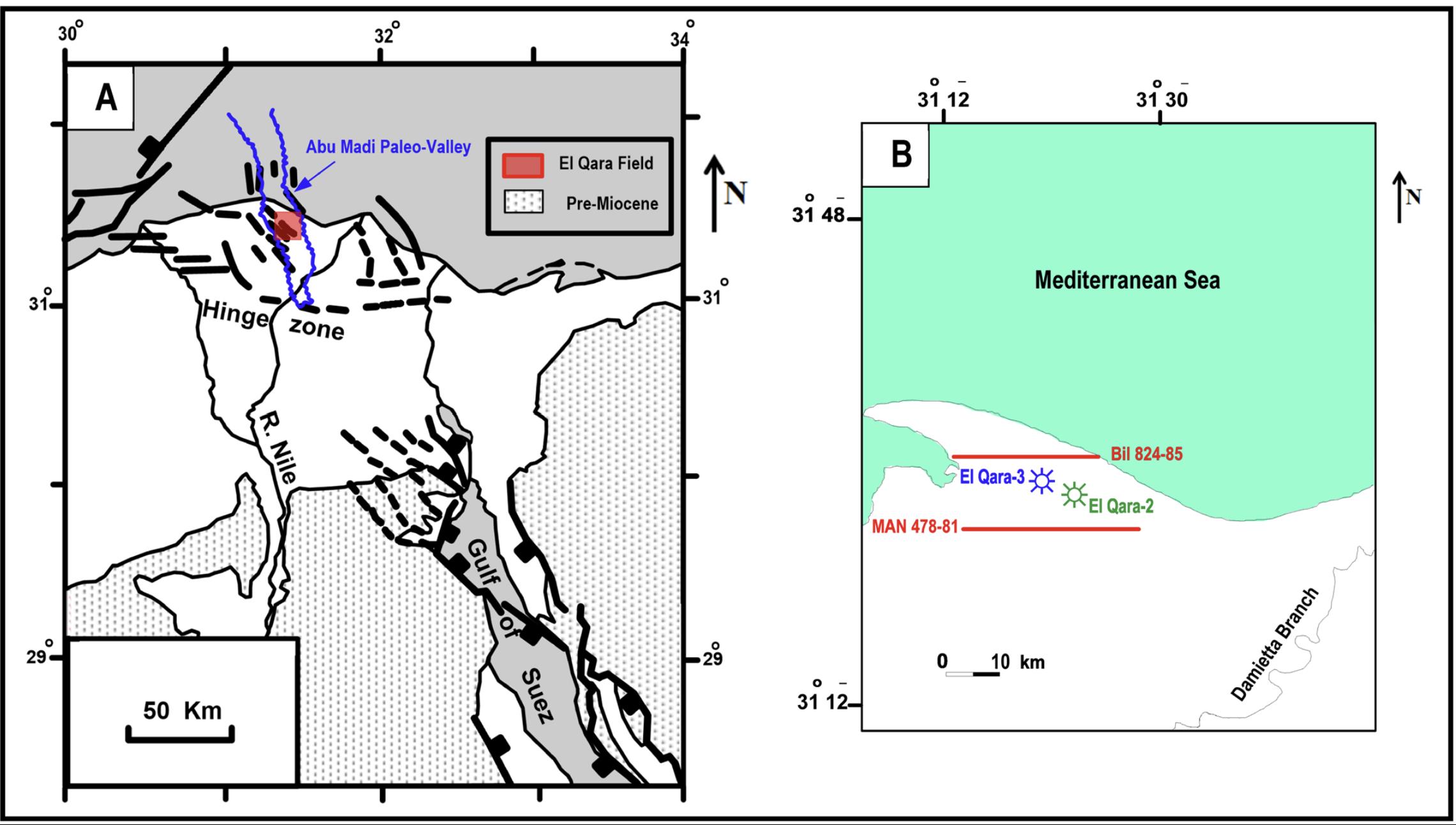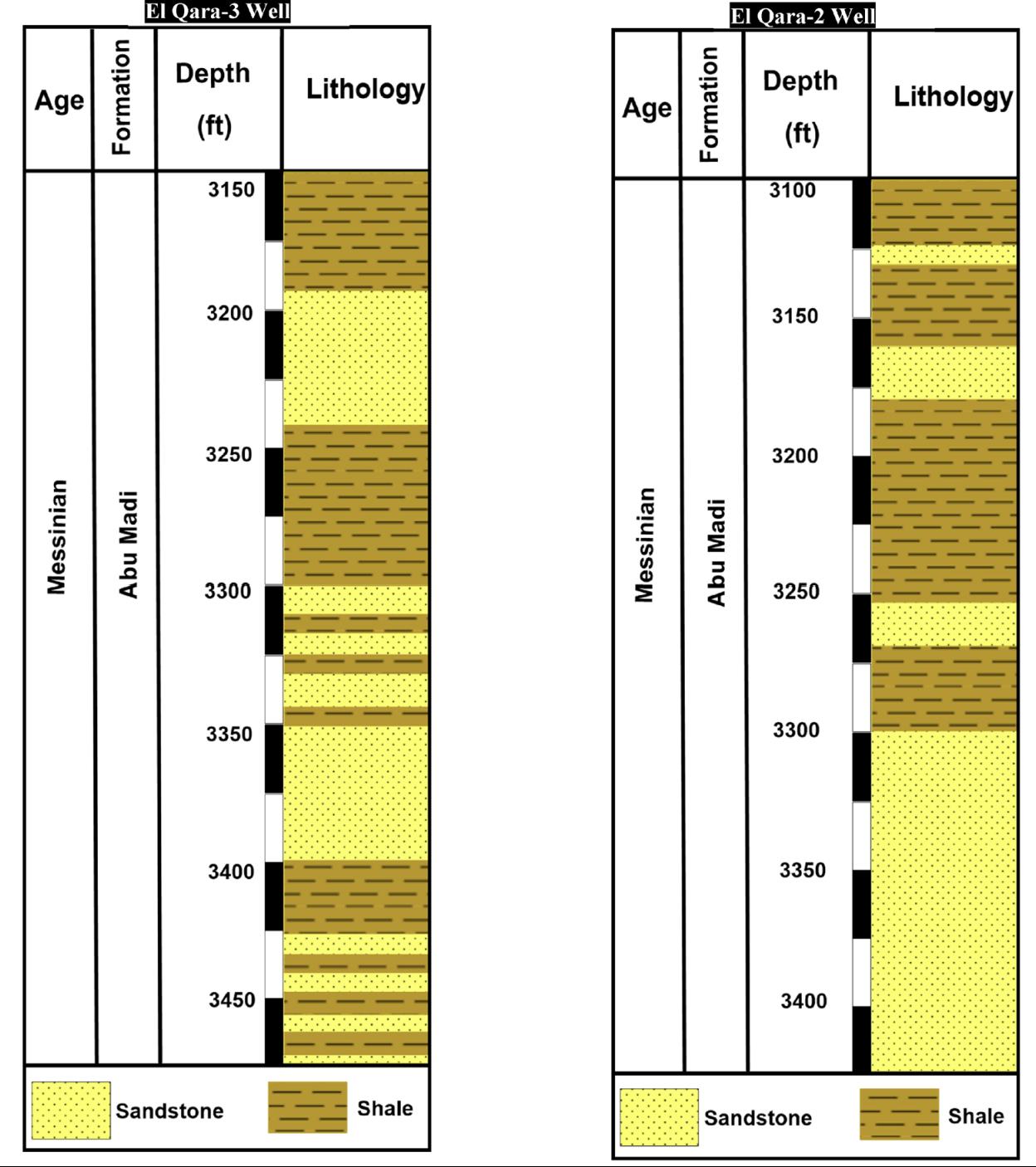
Класс Месторождения: Крупное
Тип Месторождения: Газоконденсатное
Местоположение:
Местность:
Стадия разработки: Добыча
Год открытия: 1967
Источник информации:
Метод открытия:
Площадь: 119.25 км²
El-Qara Field
Nile Delta Basin (NDB) is a passive-margin basin occupying approximately 250,000 km2 in the eastern Mediterranean area. It was formed because of the thermal subsidence consequent of the extensional tectonic phase, which isolated the African plate away from the Eurasian plate during the Late Triassic–Early Cretaceous age (Dolson et al. 2001; May 1991).
El-Qara Field lies within the Abu Madi Paleovalley to the north of NDB close to the Egyptian Coast (Fig. 1). It contains several drilled wells that produce gas from the sandstones of Abu Madi Fm. In this study, two wells in El-Qara Field were examined, namely, El-Qara-2 and ElQara-3. El-Qara-2 well was drilled with a total measured depth of 3460 m at the intersection between latitude 31° 28′ 57.1640″ N and longitude 31° 18′ 40.8516″ E. Alternatively, El-Qara-3 well has a total measured depth of 3505 m at the point between latitude 31°29′ 34.91″ N and longitude 31°16′ 54.641″E (Fig. 1)

Fig. 1 a Map displays the location of El-Qara Field, northern Nile Delta Basin, and summarizes the active faults within the Abu Madi Paleovalley during the Late Miocene age (Sarhan et al. 2014). b Locations of El-Qara-2 and El-Qara-3 wells and two interpreted seismic profles in the examined feld
NDB exhibits a thick sedimentary section from the Tertiary to Quaternary ages. Throughout the Jurassic–Early Cretaceous, a major faulted and generally fexed zone formed in the northern Egypt, called the “Hinge Zone” (Said 1962; Sestini 1989). This zone separates the northern Egypt on an east–west trend (Mosconi et al. 1996), characterizing the southern boundary of the rifted continental margin (Bertello et al. 1996) and controlling the stratigraphic and structural evolution of the north–central basins in Egypt (Said 1981; Harms and Wary 1990; Arisi et al. 1994). Numerous extensional faults formed along this Hinge Zone with strong faulting downward to the north resulted in a signifcant thick sedimentary succession (5000–7000 m) to the north of the hinge line, while only 500–1500 m of the sedimentary cover was documented to the south (Harms and Wray 1990; Sarhan and Hemdan 1994; EGPC 1994).
The NDB underwent dynamic subsidence throughout the Late Miocene owing to the uplift of Sinai and the Eastern Desert and the start of the Gulf of Suez rift and the Aqaba–Jordan shear (Kamel et al. 1998). However, during the Pliocene–Pleistocene age, a belt of compression was developed, associated with the sinistral wrench movement. This phenomenon led to the creation of the northeast–southwest Pelusium fault, which crosses the northwest seaward parts of Sinai, bounds the southern part of the Nile Delta, and expands to the western part of the African plate (EGPC 1994; Zaghloul et al. 2001).
The Miocene section in the NDB includes the Abu Madi Fm. (or its equivalent Rosetta Fm.) and Qawasim Fm. from top to bottom, characterizing the Messinian age. The Sidi Salim Fm. represents the Middle Miocene age, and the Qantara Fm. represents the Early Miocene age. The Pliocene succession in the NDB includes the Mit Ghamr Fm. and El Wastani Fm. from top to bottom, representing the Late Pliocene age and the Kafr El-Sheikh Fm. of the Early–Middle Pliocene age (El Heiny and Enani 1996; EGPC 1994; Vandre et al. 2007).
Generally, the Abu Madi Fm. in EL-Qara Field comprises sandstones with shale interbeds. Based on the composite logs of EL-Qara-2 well, all the shales are gray, dark gray, frm, sub-blocky, silty grained, and locally to siltstone, calcareous, and locally highly calcareous, and occasionally pyritic. However, the sandstone beds are quartzose, grayish, of white, fne to coarse grained in the basal sand body, fne to medium grained, occasionally coarse grained, moderately to poorly sorted in the middle–upper part, weakly to moderately cemented by calcareous cement, moderately hard to friable, and locally glauconitic (Fig. 2).

Fig. 2 Lithostratigraphic column for Abu Madi Fm. based on the available composite logs for El-Qara-2 and El-Qara-3 wells
According to the composite logs of EL-Qara-3 well, the shale beds are light gray, frm, sub-blocky, silty to very silty grained to siltstone in some parts, and noncalcareous to slightly calcareous and show traces of glauconite. However, the sandstone interbeds are quartzose, colorless, occasionally orange, fne to medium grained, locally coarse grained, subrounded to subangular, moderately sorted, carbonatic cement, and semi friable (Fig. 2).
Data source: Assessing hydrocarbon prospects in Abu Madi formation using well logging data in El‑Qara feld, Nile Delta Basin, Egypt. Mohammad Abdelfattah Sarhan, 2021
Следующее Месторождение: NC100-L-001